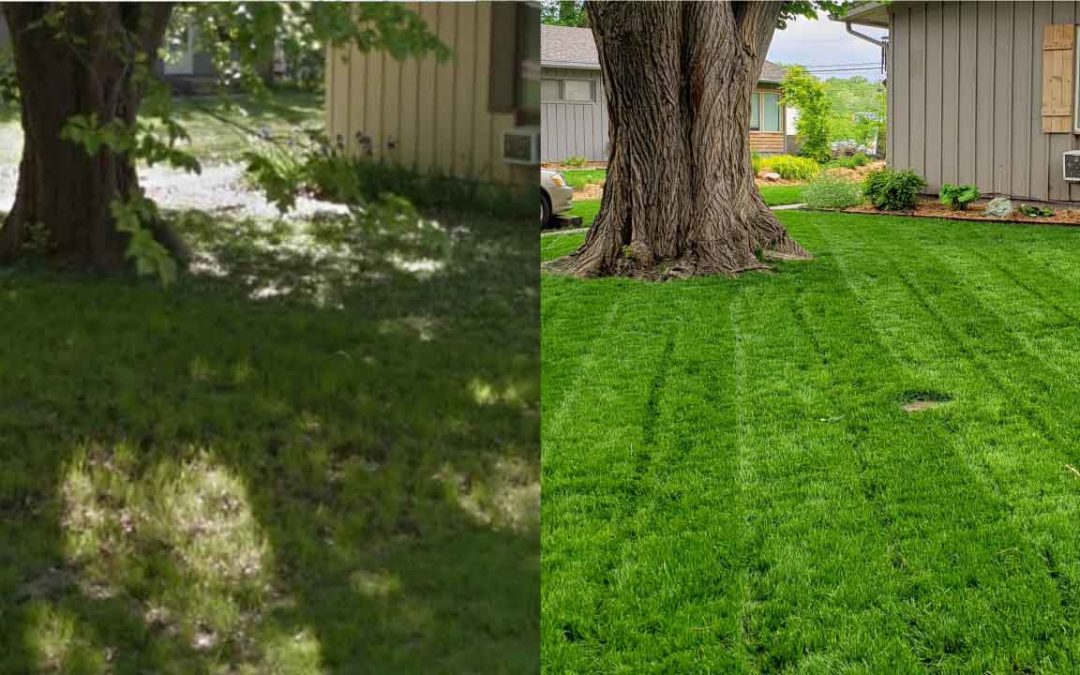Why Does Grass Die Under Shade Trees?
Customers come into our stores every fall and ask, “Why does my grass keep dying under my shade tree?” It’s always the same story, “My grass looked great after I overseeded last fall. It looked amazing in the spring but died out during the summer.” So the short answer is that trees are bullies.
Growing Grass Under Trees, It’s Not All About Sunlight
What would seem to be the most apparent resource in short supply would be sunlight; however, the area under the tree can be shady, but it is rarely too shady to sustain turf. So what is happening under the tree is that the tree will out-compete the turf grasses for resources necessary for a healthy life. The most significant shortage is water. Imagine how much water it takes to support a full-grown tree having several acres of leaf surface from which water evaporates.
Trees are Like Giant Drinking Straws
Trees draw up water from roots through a process of transpiration. Transpiration is water evaporation through the leaves. This evaporation creates negative water pressure and works much like a drinking straw using the tree’s xylem to draw water upward from the roots into the tree and, eventually, to the leaves.
The xylem is the water highway for plants to transport water and nutrients from the roots to the leaves. Grass plants also contain xylem. The grass xylem is a one-lane country road compared to a tree as a one-way eight-lane super highway. Consequently, the trees will move water faster and in higher volume than grass plants.
Why Shaded Grass Areas Grow Great in the Spring
Weather and the environment influence transpiration. The shorter daylight hours of spring, frequent rains, and cloudy weather reduce the transpiration process; thus, the tree uses less water, leaving plenty of moisture available for grass plants. As a result, the trees and grass are simpatico, and everyone gets along.
Why Shaded Grass Areas Die In the Summer
Unlike spring, during summer, we have infrequent rainfall, constant southern winds, extreme temperatures, and longer daylight hours, which will intensify transpiration. The rise in transpiration means the trees are sucking more water from the soil, sometimes hundreds of gallons per day, to support themselves. This situation creates a battle for water between the tree and your grass, and it is magnified during drought seasons.
How to Keep Grass Growing in Heavy Shade
Compensating for this unfair advantage, the tree holds over the turf; we try to level the playing field in several ways. First, always water the shaded areas more frequently during the hot, dry summer months. Second, Relieving compaction by mechanical core aerating and filling the aeration holes with Primera Sports Field Conditioner will increase the water-holding capacity.
Importance of Healthy Soil Under Large Trees
Tree roots need permeable soils to exchange air between the root zone and the atmosphere. This process is called respiration. Respiration is the opposite of photosynthesis. The tree roots take in carbon dioxide to produce sugars and oxygen as a food source. Less-than-ideal growing conditions for large trees will reduce the groundwater available from the soil to support the tree and your grass.
See Related: Fertilizing for Healthier Trees
Tree Roots Need Room to Grow and Spread
The feeder roots for trees will extend two to three times the tree’s drip line. The largest concentration of tree roots will be in the top two to three feet of the surface. Imagine a massive pin oak tree growing in the middle of a tiny front lawn. You have a house and foundation along one side of your yard, your driveway on one side, possibly the neighbor’s driveway on the opposite side, and a sidewalk or street on another. Where do you think those tree roots are going to grow? The root system that supports that 40-foot tree is super condensed into this tiny lawn. Surrounded by concrete, the pin oak is essentially planted in a huge concrete planter. When planting a tree, give the tree plenty of space to grow up and plenty of room for root growth.
Aerating the Soil Around Tree Surface Roots
Often areas with heavy root concentration leave large surface roots within the critical root zone and dense, compacted feeder root zones, making it almost impossible to core aerate mechanically to loosen the soil and allow better water and nutrient penetration. An alternative solution to a mechanical core aerator is non-mechanical soil aeration using a granular application of Soilbuilder C20.
See Related: Soil Builder Feeding Beneficial Soil Microbes
Trim Lower Branches to Help Grass Grow Under Trees
Lack of beneficial sunlight also plays a part in grass performance. Pruning lower branches to raise the canopy will help to increase sun exposure from the sides and allow for better wind circulation to fight turf disease. However, little can be done to improve the quality of sunlight coming from directly above. A university study found that 95% of the most beneficial sunlight is absorbed by the tree’s leaves, leaving little to land upon the grass plants.
As grass plants mature, more sunlight is required to maintain health and vigor. In full sun, grass blades reach towards the sky to soak up healthy sunlight and flourish. The grass plant reacts the same way in the shade, searching for quality light. Unfortunately, having reduced light levels result in a thinner and less vigorous grass plant. Weakened grass plants are less tolerant of drought, heat, and disease. In addition, the lack of vigor will affect turf density allowing weeds to invade thin areas.
Lessons Learned From Mother Nature
Mother Nature designed her baby grass seeds for sprouting and tolerating lower light conditions under the shadow of established taller grasses. Re-seeding dense shade areas three times a year (April, June, and September)) will add new generations of youthful, vigorous, and low-light tolerant grass plants to the maturing turf stand.
Best Grass Seed to Grow in Shade
Uncle’s Premium Shade grass seed is the ideal blend of elite grass seed varieties to introduce genetic diversity with lower water and nutrient requirements, improved shade tolerance, and disease resistance.
See Related: Five Tips for Growing Grass Under Shade Trees
More Related Articles to Growing Grass
5 Tips on Growing Grass Under Shade Trees
- Why grass won’t grow under big trees. Learn More at this Link
How Much to Water New Grass Seed?
- Planting new seed? How often should you be watering? Learn More at this Link
Seasonal Mowing Heights
- The seasons will determine how short or tall to mow your lawn. Learn More at this Link
Mowing Wet Grass
- Should you mow wet grass? Learn More at this Link


